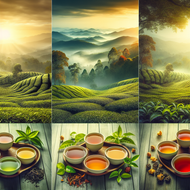The Impact of Climate on Tea Flavor Profiles
Posted by Ricardo R Matos on Jan 27th 2025
The Impact of Climate on Tea Flavor Profiles | TeaTheWorld
The Impact of Climate on Tea Flavor Profiles
At TeaTheWorld, we pride ourselves on providing premium organic teas that offer exceptional quality and taste. But have you ever wondered why one cup of tea can taste so different from another, even if they are both made from the Camellia sinensis plant? One of the most significant factors that influence the flavor profiles of tea is climate.
The Role of Climate in Tea Cultivation
Tea is sensitive to its growing environment, and climate plays a crucial role in shaping the flavor, aroma, and overall quality of the leaves. The three main climatic factors that affect tea cultivation and flavor are temperature, rainfall, and sunlight. Let's take a closer look at each of these elements to uncover the secrets behind the unique flavor profiles of premium teas.
1. Temperature
The temperature of a tea-growing region can significantly affect the growth cycle of tea plants. Warmer climates generally promote quicker growth, which can lead to a more subtle, milder flavor. In contrast, cooler climates slow down the growth of the tea leaves, resulting in a more concentrated flavor and robust aroma.
For instance, teas cultivated in cooler regions like Darjeeling, India, are known for their exquisite floral notes and astringency, while those from warmer regions, such as Assam, possess a bold and malty character. This temperature-induced variation means that the same type of tea grown in different climates can yield distinctive flavors that appeal to various palates.
2. Rainfall
Rainfall is another vital climatic factor that affects tea. The amount and timing of rainfall can influence the uptake of nutrients in the tea plant and its overall health. In regions with ample rainfall, tea plants can flourish and produce tender leaves with higher concentrations of essential oils, contributing to intense flavors and aromas.
For example, plantations in regions like Sri Lanka receive consistent monsoon rains, allowing the tea leaves to thrive and contribute to the bright, citrusy notes characteristic of Ceylon teas. Conversely, drought-prone areas may produce teas with bolder yet less nuanced flavors, as the plants struggle to maintain moisture content, producing thicker leaves that may develop earthier tones.
3. Sunlight
Sunlight not only affects the growth of tea plants, but it also significantly impacts their flavor. The amount of sunlight received can enhance the photosynthesis process, leading to higher levels of chlorophyll and associated compounds that resonate in the taste profile of the tea.
Teas grown in regions with high sun exposure, such as those found in Japan, can develop a rich umami flavor and vibrant green color, famously seen in sencha and matcha teas. On the other hand, teas that are shaded, like gyokuro, have a sweeter and more delicate flavor profile due to reduced photosynthesis, which alters the composition of the leaves.
Conclusion
The flavor profiles of tea are a tapestry woven from the threads of climate—temperature, rainfall, and sunlight all combine to create the diverse range of tastes we enjoy in our cups. At TeaTheWorld, we're not just offering you high-quality premium organic teas; we are inviting you to experience a world where each sip tells the story of its origin, the climate that nurtured it, and the meticulous care involved in its production.
Next time you brew up a cup of our organic tea, take a moment to appreciate the unique flavors that climate has crafted in every leaf. With every sip, you are not just enjoying a beverage; you are experiencing a piece of the earth's ecosystem and the dedication of tea artisans around the world.

